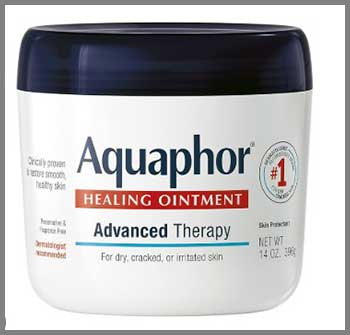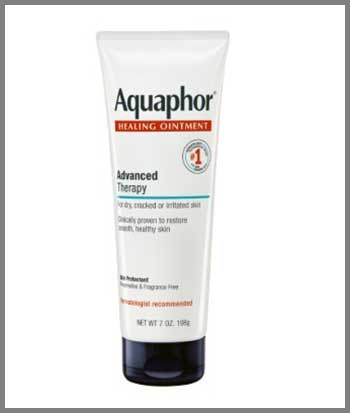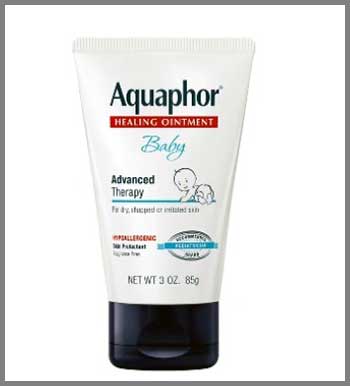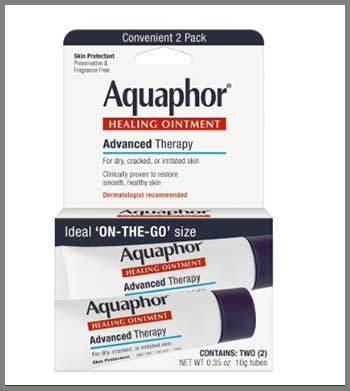I’ve tried countless skincare products, but Aquaphor Healing Ointment stands out as a must-have. Whether you’re battling dry, cracked skin or need a reliable solution for minor cuts and chapped lips, this multi-purpose ointment delivers.
It’s a dermatologist-recommended, fragrance-free lifesaver that creates a protective barrier to lock in moisture and promote healing. From soothing irritated skin to keeping your hands soft in harsh winters, Aquaphor is a game-changer you’ll want in your bathroom cabinet. Trust me, it’s worth every penny for healthy, hydrated skin.
My Journey With Aquaphor Healing Ointment

Let me take you back to last winter when my hands were a disaster. Working in a busy retail job, I was constantly handling rough cardboard boxes and washing my hands a dozen times a day. My knuckles were cracked, my cuticles were peeling, and every movement stung.
I’d tried lotions, but they just sat on my skin, offering temporary relief before the dryness crept back. That’s when a coworker tossed me a small tube of Aquaphor Healing Ointment and said, “This stuff works miracles.” Skeptical but desperate, I gave it a shot.
That first night, I slathered it on my hands after a shower, and the thick, glossy texture felt different—more substantial than any lotion I’d used. It wasn’t greasy in that annoying, slippery way; it sank into my skin, creating a shield that seemed to hold moisture in place. By morning,
the cracks on my knuckles were less angry, and my cuticles looked less like a horror show. I was hooked. Over the next few weeks, I used it on my elbows, heels, and even my lips when they started chapping from the cold. Each time, Aquaphor delivered, soothing irritation and softening rough patches.
What surprised me most was its versatility. I started using it on a small burn from a cooking mishap, and it calmed the sting while keeping the area protected. I even dabbed it on my face during a particularly dry spell, and my skin felt plump and hydrated without breaking out. It’s not just a product—it’s become my go-to for any skin issue. Whether I’m dealing with windburn from a chilly hike or a scrape from tripping on the sidewalk, I reach for that familiar blue and white jar. It’s like having a dermatologist in my pocket.
What Makes Aquaphor Special
Aquaphor Healing Ointment isn’t your average moisturizer. It’s a water-free ointment with 41% petrolatum, a skin protectant that forms a semi-occlusive barrier. This barrier lets oxygen flow to the skin while locking in moisture, creating an ideal environment for healing. It also contains humectants like glycerin and panthenol, which pull moisture into the skin, and soothing ingredients like bisabolol, derived from chamomile, to calm irritation. Unlike lotions that evaporate quickly, Aquaphor stays put, delivering long-lasting hydration. It’s fragrance-free, dye-free, and non-comedogenic, making it gentle enough for sensitive skin, babies, and even post-procedure care like tattoos or minor surgeries.
Pros Of Aquaphor Healing Ointment
I’ve been using Aquaphor for over a year now, and it’s earned its spot as a staple in my routine. Here’s why I think it’s worth raving about:

- Versatility for multiple skin issues: This ointment is a Swiss Army knife for skincare. I’ve used it on chapped lips, cracked heels, minor cuts, and even as a nighttime face mask when my skin feels parched. It tackles everything from dry patches to small burns with ease, making it a one-stop solution for the whole family.
- Long-lasting hydration: Unlike lotions that I have to reapply every few hours, Aquaphor’s thick formula stays put. I apply it to my hands before bed, and I wake up with soft, hydrated skin. It’s especially great during winter when my skin drinks up moisture like a sponge.
- Gentle on sensitive skin: My skin can be fussy, reacting to fragrances or harsh ingredients with redness. Aquaphor is fragrance-free and dye-free, so it’s never caused irritation, even on my most sensitive areas like around my eyes or on my lips.
- Promotes faster healing: I noticed that small cuts and scrapes heal quicker when I use Aquaphor. The semi-occlusive barrier keeps the wound moist, which my dermatologist says is key for healing. It’s also amazing for post-tattoo care, keeping the area protected without suffocating it.
- Economical use: A little goes a long way. I’ve had a 14-ounce jar for months, and it’s barely half-empty despite daily use. You don’t need to slather it on; a thin layer does the job, making it cost-effective.
Also Read: My Thoughts on Cindy Crawford Meaningful Beauty.
Cons Of Aquaphor Healing Ointment
No product is perfect, and while I love Aquaphor, there are a few downsides I’ve noticed:
- Greasy texture: The ointment’s thick, petrolatum-based formula can feel greasy, especially if you overapply. I learned this the hard way when I used too much on my hands and left smudges on my phone screen. It absorbs over time, but it’s not ideal for daytime use on visible areas like your face unless you’re slugging at night.
- Not vegan-friendly: Aquaphor contains lanolin alcohol, derived from sheep’s wool, which rules it out for vegans. I don’t follow a vegan lifestyle, but if you do, this could be a dealbreaker. I wish they’d offer a vegan alternative for broader appeal.
- Potential for staining: The oily texture can leave marks on fabrics if you’re not careful. I once got some on a new couch cushion, and it left a faint stain that took effort to clean. Now I’m cautious about applying it before sitting on furniture or wearing light-colored clothes.
- Not suitable for deep wounds: Aquaphor isn’t meant for serious injuries like deep cuts or animal bites. I made the mistake of using it on a deeper scrape once, and my doctor warned me to stick to antiseptic ointments for anything more than minor wounds to avoid infection.
- Packaging issues: The tube can dispense too much product if you’re not careful, and some users report the formula separating in jars. I’ve had a tube where the oil separated, making it messier to apply. Checking the expiration date helps, but it’s a hassle when it happens.
Maintenance Tips For Using Aquaphor
To get the most out of Aquaphor, you need to use it smartly. Here are my tried-and-true tips for making it work like a charm:
Apply on Damp Skin for Maximum Hydration

I’ve found that Aquaphor works best when you apply it to slightly damp skin. After a shower or washing your hands, pat your skin dry but leave it a tad moist. Then, spread a thin layer of Aquaphor. The dampness helps the humectants like glycerin pull moisture into your skin, and the petrolatum locks it in. I do this on my hands and feet, and the difference is night and day—my skin stays soft for hours.
Use Sparingly to Avoid Greasiness
You don’t need a thick glob of Aquaphor to see results. I made the rookie mistake of piling it on, thinking more was better, but it just made my hands slippery. A pea-sized amount is enough for your hands or lips. Rub it in gently, and give it a minute to sink in. If you’re using it on your face for slugging, a thin layer over your moisturizer at night is plenty.
Pair with Cotton Gloves or Socks for Intensive Treatment
For cracked hands or heels, I swear by this trick: apply Aquaphor generously before bed, then slip on 100% cotton gloves or socks. I wake up with baby-soft skin, and it’s especially helpful for my eczema-prone hands. The cotton traps the moisture without making you feel sweaty, and it keeps the ointment from rubbing off on your sheets.
Store Properly to Maintain Consistency
I’ve had a jar of Aquaphor separate into oil and ointment, which was annoying. To avoid this, store it in a cool, stable environment—think a bathroom cabinet, not a sunny windowsill. Check the expiration date, too, since expired product can lose its mojo. If you notice separation, give it a quick stir before applying, but contact Aquaphor’s team if it’s a recurring issue.
Cleanse Thoroughly Before Reapplying
If you’re using Aquaphor daily, especially on your face, make sure to cleanse your skin well before reapplying. I noticed that skipping a proper cleanse led to a slight buildup that made my skin feel heavy. Use a gentle cleanser to remove any residue, then apply Aquaphor to clean skin for the best results.
Comparison With Other Brands
Aquaphor isn’t the only player in the skincare game, so I’ve pitted it against some popular alternatives to see how it stacks up. Here’s how it fares against Vaseline, CeraVe Healing Ointment, and Eucerin Original Healing Cream.
Vaseline Healing Jelly Original

Vaseline is the OG of petroleum jelly, with a formula that’s 100% petrolatum compared to Aquaphor’s 41%. I’ve used Vaseline for chapped lips and minor cuts, and it’s great at sealing in moisture. But it lacks the humectants like glycerin and panthenol that Aquaphor has, so it doesn’t hydrate as deeply. Vaseline feels heavier and greasier, which I don’t mind for overnight use but find less practical during the day. It’s also vegan-friendly, unlike Aquaphor, which is a plus if you avoid lanolin. For wound healing, some studies suggest Vaseline causes less redness at surgical sites, but I find Aquaphor’s added ingredients make it more soothing for irritated skin.
Read More: My Thoughts on Dime Beauty’s Blue Facial Oil.
CeraVe Healing Ointment
CeraVe Healing Ointment is another dermatologist favorite, and I’ve tried it for dry patches and post-procedure care. It’s similar to Aquaphor with 46.5% petrolatum and includes ceramides and hyaluronic acid, which are fantastic for repairing the skin barrier. I noticed CeraVe absorbs a bit faster, making it less greasy, but it’s not as versatile—Aquaphor wins for uses like lip care or tattoo healing. CeraVe’s formula feels lighter, which I prefer for daytime, but Aquaphor’s thicker barrier is better for severe dryness or cracked heels. If you want ceramides, CeraVe might edge out, but Aquaphor’s simplicity and multi-purpose nature keep it in my top spot.
Eucerin Original Healing Cream
Eucerin’s Original Healing Cream is a solid contender, and I’ve used it for my dry, eczema-prone hands. It’s petrolatum-based like Aquaphor but includes mineral oil and lanolin, with a creamier texture that’s less sticky. I found it hydrates well but doesn’t form as strong a protective barrier as Aquaphor, so it’s not as effective for cracked skin or minor wounds. Eucerin is also fragrance-free and great for sensitive skin, but it’s pricier, and I didn’t see the same healing speed for cuts or burns. Aquaphor’s thicker consistency and broader uses make it my go-to over Eucerin.
My Ongoing Experience and Results
After months of using Aquaphor, I can say it’s transformed how I handle my skin issues. My hands, once a cracked mess, are now soft and smooth, even during busy workdays. I’ve also started using it as a slugging layer on my face at night, especially when I’m using tretinoin, which can leave my skin flaky. The glow I get from slugging is unreal—my skin looks dewy and plump, and I’ve had friends ask what I’m using. Even my husband, who’s skeptical of skincare, swears by it for his cracked heels after I convinced him to try it.
One thing I’ve learned is that Aquaphor isn’t a cure-all. It’s fantastic for surface-level issues, but for deeper skin conditions like severe eczema or psoriasis, I pair it with a prescription cream as my dermatologist advised. It’s also not a substitute for sunscreen or acne treatments, so I use it as part of a broader routine. But for everyday dryness, minor injuries, or protecting my skin from harsh weather, it’s unmatched. I keep a small tube in my bag and a big jar at home, so I’m never without it.
Frequently Asked Questions (Faq)
Aquaphor’s greasy texture can be a turn-off if you don’t like heavy products, and it might leave marks on clothes or furniture if you’re not careful. It’s not vegan due to lanolin alcohol, which disappoints some users. It’s also not meant for deep wounds, as it could trap bacteria, and some folks report issues with the formula separating in jars or tubes, which makes application messy.
Absolutely, it’s a fantastic healing ointment for minor skin issues. It’s clinically proven to restore smooth, healthy skin by creating a semi-occlusive barrier that promotes healing for cuts, scrapes, burns, and dry patches. Dermatologists love it for its gentle, fragrance-free formula, and I’ve seen it work wonders on my cracked hands and chapped lips.
Don’t use Aquaphor on deep or puncture wounds, animal bites, or serious burns, as it’s not an antiseptic and could trap bacteria. Avoid getting it in your eyes, as it can cause irritation. If you have a lanolin allergy, steer clear, as it might cause redness or itching. Always consult a doctor for severe skin issues.
Dermatologists recommend Aquaphor because it’s a versatile, non-irritating skin protectant with 41% petrolatum, which locks in moisture and supports healing. Its humectants like glycerin and panthenol hydrate the skin, while bisabolol soothes irritation. It’s fragrance-free, dye-free, and non-comedogenic, making it safe for sensitive skin, babies, and post-procedure care like tattoos or minor surgeries.
Final Thoughts On Aquaphor Healing Ointment
Aquaphor Healing Ointment has earned its place as my skincare hero. It’s a reliable, versatile solution that tackles everything from dry skin to minor wounds with ease. Whether you’re soothing chapped lips or healing cracked heels, this dermatologist-approved ointment delivers results. Grab a tube or jar and see the difference for yourself—you won’t regret it.
